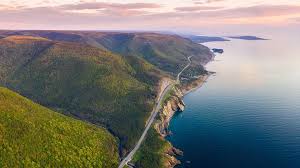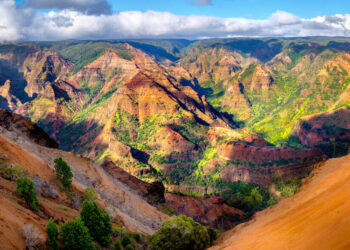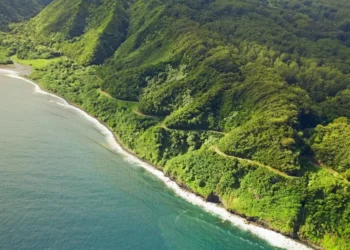Winding along the northern edge of Cape Breton Island in Nova Scotia, the Cabot Trail isn’t just a road—it’s a thread that pulls you through cliffs, forests, and little coastal hamlets. Stretching about 300 kilometers, this loop wraps around the Cape Breton Highlands, tossing up views that flip from craggy ocean bluffs to valleys draped in green. People call it “Canada’s Amalfi Coast” sometimes, and sure, the beauty’s there—but it’s got a grit and a heartbeat all its own, whispering tales of tough folks and wild splendor. Whether you’re drawn by the vistas, the trails, or just a need for quiet, here’s a take on what this legendary route’s all about.
Getting There: Kicking Off the Ride
The Cabot Trail loops around Cape Breton Island, so step one is landing in Nova Scotia’s northeastern corner. After that, it’s all about hitting the road.
Most folks kick things off in Baddeck, a little lakeside spot an hour from Sydney, the island’s main hub. Flying in? JA Douglas McCurdy Sydney Airport (YQY) hooks up through Halifax or Toronto—small, no fuss, with rental cars right there. Picture rolling into Baddeck by midday, the Bras d’Or Lake shimmering like a tease. From mainland Nova Scotia, take the Trans-Canada Highway (Route 104) to the Canso Causeway—three hours from Halifax, a steady haul with a deer or two to dodge.
The loop’s a solid eight-hour drive if you blast through, but that’s not the game. Stretch it to three days—linger at lookouts, poke down trails—and it feels right. Start in Baddeck and pick your direction: clockwise keeps the ocean on your right, handy for pulling over when the views hit hard.
When to Roll: Seasons Paint the Picture
The Cabot Trail shifts with the calendar. Summer—June to August—brings warm days, 20-25°C, and stretched-out light. Wildflowers speckle the hills, and every scenic stop’s buzzing with cameras. Think salt air mingling with pine—thick and alive.
Fall, September to October, steals the show—maples and birches explode in red and gold, a wild splash against gray cliffs. Cooler, emptier, with a glow that turns the road into some artist’s mad vision. Winter clamps down hard—snow and ice can close chunks off—but it’s got a stark, lonely beauty if you’re up for it.
Spring, May to June, shakes off the frost, green creeping back with a fresh snap in the breeze. Summer or fall’s the sweet spot for a first spin.
Where to Crash: Spots to Rest
Places to stay sprinkle the trail, from motels to cabins tucked tight to the land. Baddeck’s Silver Dart Lodge has cozy digs and lake views—a good perch to start or wrap up, mist curling off the water at dawn. Chéticamp, a fishing village on the west side, offers Laurie’s Inn—basic, tidy, with a whiff of Acadian soul. Folks there might nudge you toward a whale-watching spot worth the detour.
For a wilder vibe, Keltic Lodge in Ingonish perches on a cliff, red roofs popping against the sea. It’s a splurge, but sipping coffee with waves pounding below sells it. Cabins and campgrounds dot the way too—Meat Cove Campground, up at the northern tip, is rough—tents, pit toilets—but those cliffs plunging to the ocean feel like the edge of everything.
The Grub: Cape Breton’s Table
Food along the trail leans heavy on the sea. Chéticamp’s Le Gabriel serves up Acadian eats—fricot, a chicken stew that hugs your insides, or cod so fresh it tastes like the tide. Baddeck’s Highwheeler Café nails sandwiches and pastries; their lobster roll’s a sloppy, glorious mess.
Seafood rules—oysters, scallops, haddock—but the local stuff shines too. Farmers’ markets in Ingonish or Pleasant Bay hawk berries and jams—blueberry preserves that stick around for weeks. Summer roadside stands sling chowder or fish cakes, no frills, just good. Wash it down with a Big Spruce Brewing pint from Nyanza—crisp ale that cuts the salt clean.
What to Catch: The Trail’s Heart
The Cabot Trail’s got a pull in its bones—here’s what stands out.
Cape Breton Highlands National Park anchors it all—186 square kilometers of peaks, plateaus, and shore. Skyline Trail’s the gem, a 4-hour loop to a lookout where hills crash into ocean—a spot that’ll steal your wind. Pleasant Bay’s whale turf—humpbacks and minkes slicing through swells, fins popping up like a shy wave.
Meat Cove marks the wild end—cliffs drop straight to the Atlantic, remote and rough. The gravel road in’s a jolt, but dusk there feels ancient. The Lone Shieling tucks into a valley—a stone cabin in old-growth woods, a quiet nod to Scottish roots, mossy and still.
Tips to Roll With: Keeping It Smooth
The trail’s paved but curvy—grab a car that handles; skip the clunkers.
Fuel up in Baddeck or Chéticamp—pumps get scarce mid-loop.
Summer’s warm, but fog sneaks in; toss a jacket in the back.
Fall’s brisk, winter’s slippery—tires count.
Cell signal drops in patches—download maps or wing it at your peril.
Hiking’s prime—Skyline’s doable, others get steep; boots beat sneakers.
Moose, foxes, eagles roam—watch, don’t poke.
Cash works for roadside buys, and don’t rush—the trail’s magic fades if you gun it.
Why It Lingers
The Cabot Trail’s more than a drive—it sticks with you. Cliffs tumbling to the sea, forests swallowing noise, a bend revealing a hamlet or a hollow—it sinks in deep. Leave with salt on your skin and a tug to come back, every mile humming with land and lives that hold tight. Solitude, a test, or beauty that stops you dead—this loop’s got it. Fill the tank, crack the windows, and let it roll out.











